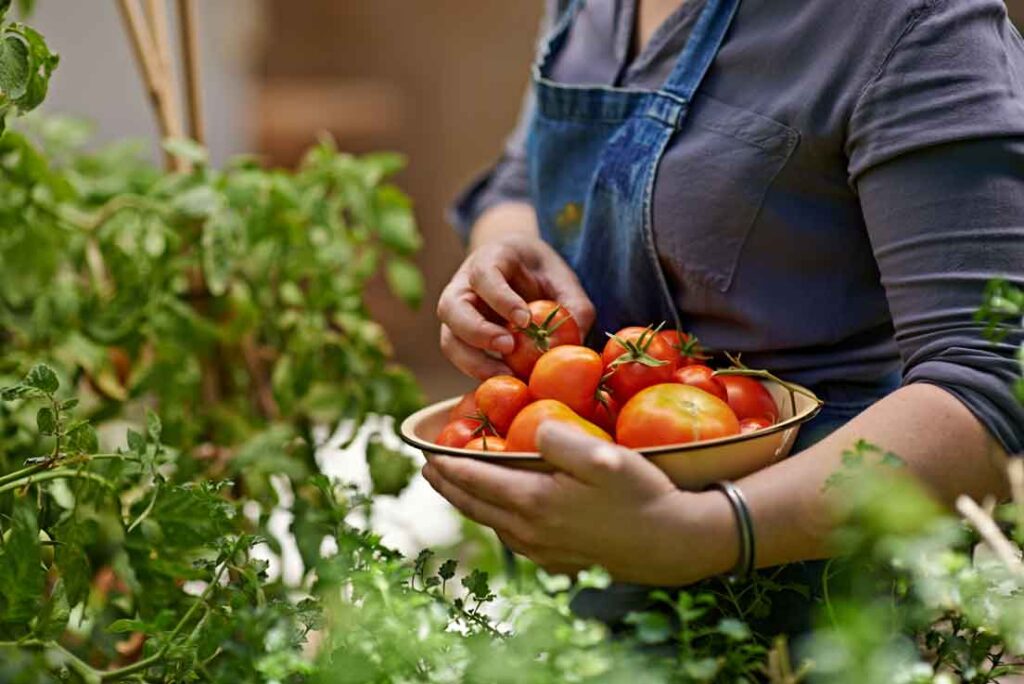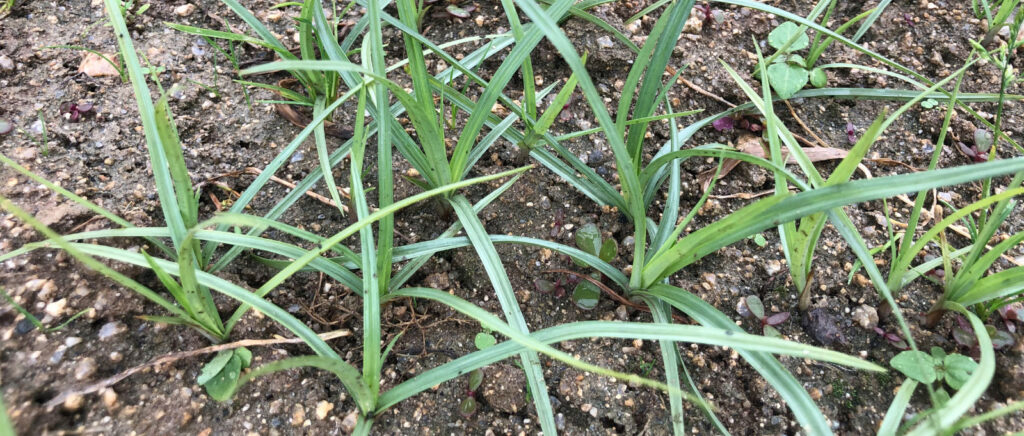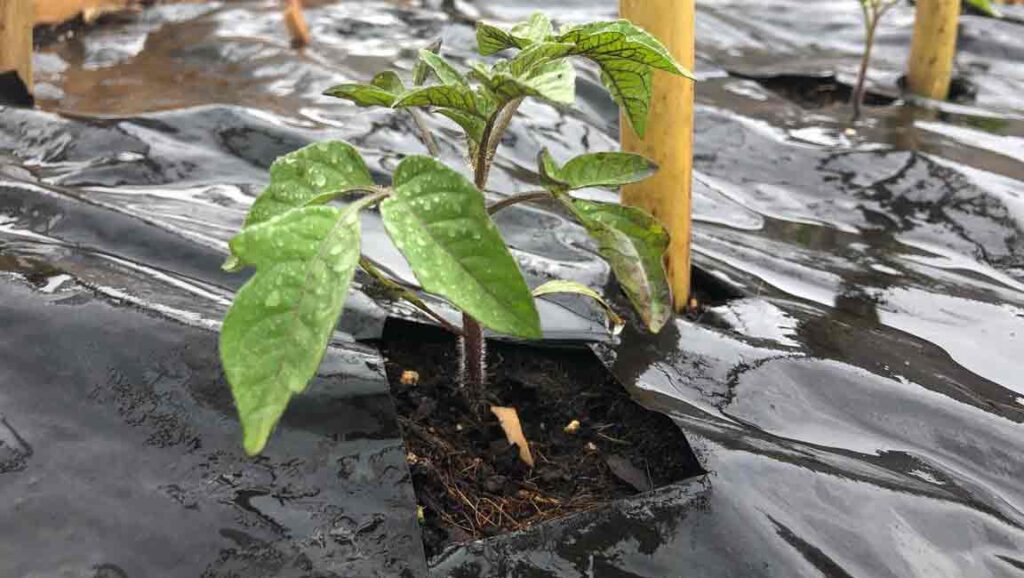Growing tomatoes is an agricultural practice we’ve developed since ancient times. Today, we consider it a highly satisfying and profitable tradition, which we implement on large tracts of land for commercial purposes, as well as in home and community gardens, in greenhouses, and in small spaces such as terraces, balconies, and pots.
In today’s agricultural section, we’ll learn all the details we need to ensure our tomato growing project is optimal and productive. Welcome!
Historical background of the tomato.
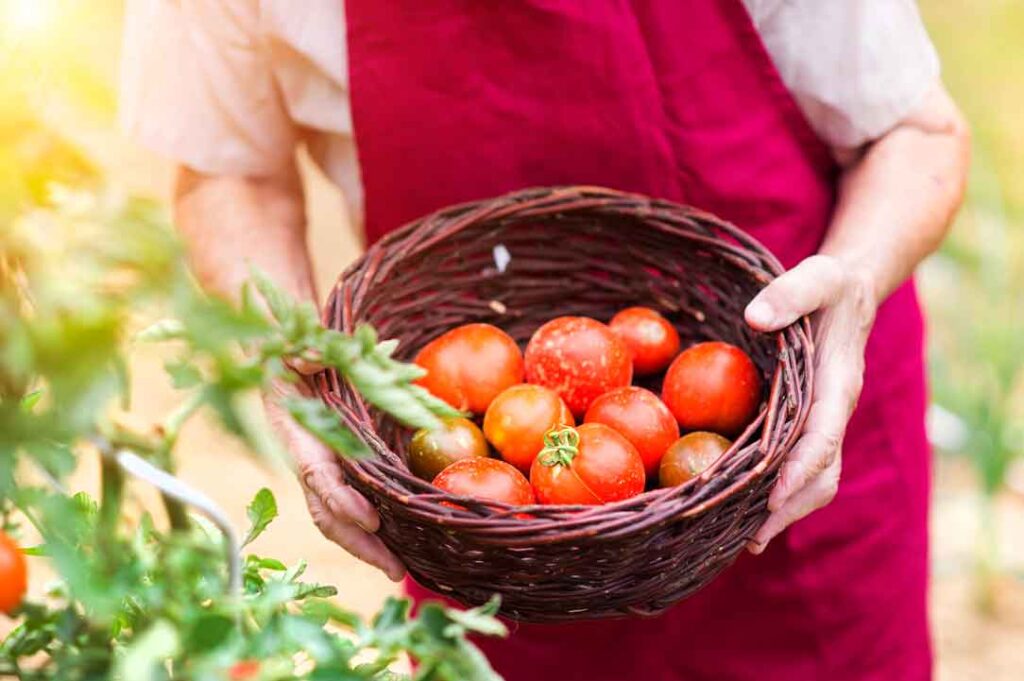
We must go back to the pre-Columbian origins of Solanum lycopersicum, the tomato, whose roots go back to the Andean regions of Peru, Ecuador and northern Chile, and to Mesoamerica, present-day Mexico and Central America, where our plant appears in its wild state, with small, acidic-tasting fruits, very similar to the cherry tomatoes we know today.
It was in these regions that the tomato was first cultivated. In Nahuatl, the word “tomatl” or “xictl” means “fruit with a watery navel.” Xito or xictli means navel, and “matl” or “tomatl” means water or fruit with liquid. This described a rounded, juicy fruit with a small depression at the bottom resembling a navel. It became part of the trade and regular diet, as these pre-Columbian cultures selected the most robust, colorful, and flavorful fruits, reproduced them, and gave rise to domesticated and varied forms.
Thus, planting tomatoes became an essential staple of Native American food, and in addition to corn, cocoa, and potatoes, in the 16th century it reached Europe and the rest of the world when the two continents met.
Known in Italy as the pomo d’oro or golden apple, the tomato began its rise to popularity and regular consumption, especially in the south of the country, and became a fundamental ingredient in the preparation of stews, sauces, and preserves.
For Spanish Mediterranean cuisine, especially in Andalusia and Catalonia, growing tomatoes is a fundamental part of agriculture and everyday consumption in these regions.
During the 19th century, Russia, India, and China were common tomato growers, and currently the main leaders in world tomato production are China, India, the United States, Türkiye, and Egypt.
Agronomic characteristics of the tomato.
When designing a roadmap for planting tomatoes, and since our goal is to achieve optimal productivity and quality, it’s very important to consider several aspects. Among them, we’ll begin by studying the agronomic characteristics of our tomatoes.
First of all, let’s now analyze the structure of tomatoes:
- Root system: It is robust, has deep main roots, and numerous secondary roots.
- Stems: They grow vertically and in the case of indeterminate crops can reach a height of more than 2 meters.
- Leaves: These should be regularly inspected to remove any stains or discoloration; this way, we conserve growth energy on healthy leaves.
- Flowers: They are small, yellow and hermaphrodite, but they can be pollinated by the effect of wind or insects.
Here are some links with information that may be of interest:
https://es.wikipedia.org/wiki/Tomate
Now, let’s briefly learn about growth habits, as we’ll later see how they operate depending on the varieties we select.
- Determinate-cycle tomatoes: These have a limited growing season and will produce fruit in short periods. Planting tomatoes with these characteristics will be very suitable for industrial purposes.
- Indeterminate tomatoes: They will grow continuously, and we will harvest fruit throughout the season. We will need to use staking and prune frequently to maintain the vigor of our plants. Tomatoes are annual plants, and we can extend their production if we keep our crops under control.
- Germination period: occurs between 5 and 10 days, at a temperature of 20° to 28°C.
- Vegetative development: This lasts until the first flowers appear, which, when pollinated, will initiate what is known as fruit set, that is, the transformation of the flower into fruit.
- Approximate development time: This will take between 90 and 150 days, depending on the variety chosen and the conditions we have set for our crop.
Tomato varieties and their agronomic behavior.
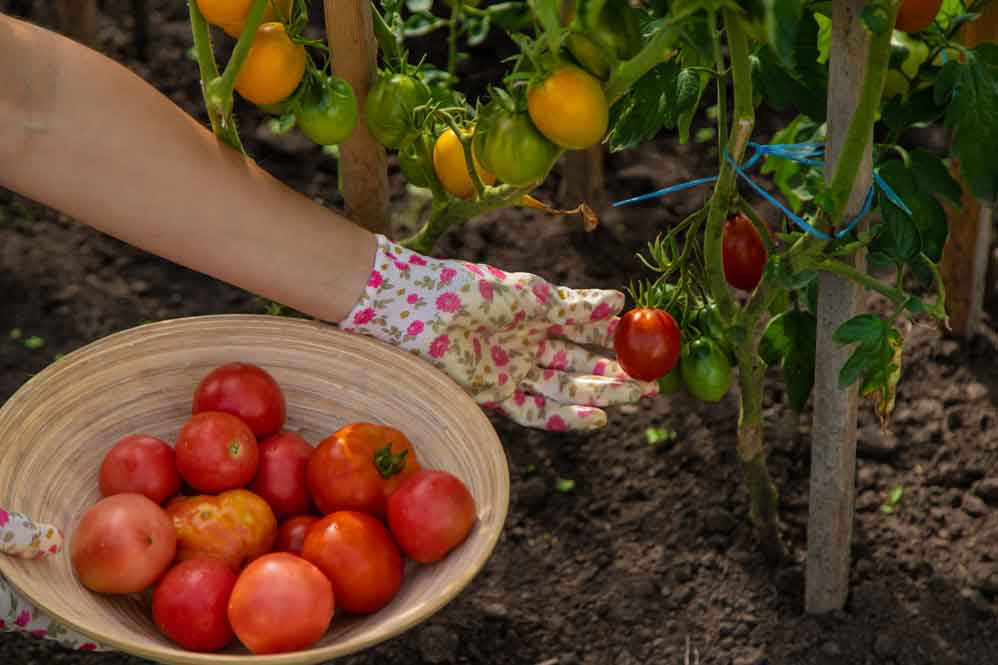
Let’s start by reviewing the varieties in detail according to their growth habits.
We have already seen that determinate tomatoes have short growing times, produce concentrated fruit crops, and are compact plants suitable for small spaces such as home gardens, community gardens, terraces, balconies, and pots, where harvesting is advantageous in short, abundant periods with minimal need for pruning and staking. Likewise, planting determinate tomatoes is suitable for regions with short growing seasons, as they produce early harvests. Let’s study.
Roma variety: Frequently grown in Mediterranean regions, it features an elongated shape, thick flesh, few seeds, and a deep red color. It has a low water content and is suitable for making sauces, purées, preserves, and dehydrated for dry consumption.
This hybrid variety was developed in the United States around 1950 and was designed for industrial processing. Today, it is cultivated globally.
Celebrity variety: This is also a medium-sized, round, and slightly flattened hybrid variety, the product of the union of two varieties with optimal genetic characteristics. The result is a fruit that is highly resistant to disease, highly productive, and ripens evenly. Celebrity is suitable and easy to manage for planting both in open fields and in greenhouses and small spaces, and prefers temperate and warm climates. It is used in salads and for eating fresh.
Río Grande variety: well-suited to hot, dry climates, it is tolerant of water stress and arid zones, but requires regular irrigation. It has a medium-sized, oval fruit, also with few seeds and a thick, low-water pulp, ideal for mashed potatoes, dehydrated foods, sauces, purées, and preserves. It adapts well to all types of environments.
Heinz 1370 variety: developed by the Heinz company in the United States and created specifically for the production of tomato paste (ketchup), sauces, and concentrates. It has a high level of disease resistance, optimal productivity, medium size, fleshy flesh, and uniform ripening, and is designed for large-scale industrialization. Easy to manage, it prefers temperate and warm climates and can be grown in open fields and greenhouses.
Ace 55 variety: This tomato is of excellent quality, and its mild flavor is ideal for fresh consumption. It has a low acidity level and its fruits are large, uniform, juicy, and seedless. This easy-to-harvest, low-maintenance variety is also productive for medium-sized and small gardens and is also suitable for planting in open fields and greenhouses.
Homestead variety: highly heat-resistant and thrives in unfavorable climatic conditions. Homestead is suitable for open field cultivation, both at high temperatures and in areas with limited water. It is well-suited for fresh consumption in salads, sauces, and preserves due to its balanced flavor, firm texture, low acidity, and fleshy pulp. Due to its high heat resistance, it is commonly grown in the Mediterranean, tropical areas, and the southern United States.
Now, let’s look at indeterminate tomato varieties.
Marmande variety: flattened and slightly wrinkled, large in size, and with low water content. This fleshy and juicy variety is ideal for stews, casseroles, salads, and gourmet cooking. It adapts quite well to the Mediterranean climate, especially in the southwestern region of France, from which it takes its name. It is highly resistant to disease, tolerant of early cold, and suitable for cultivation in open fields and greenhouses.
Muchamiel variety: native to Spain, it is best eaten fresh in salads for its intense flavor and juicy texture. It is a large, lobed variety and highly prized in this Mediterranean region.
San Marzano variety: This is an elongated tomato with fleshy flesh and low water content. Native to Italy, it’s perfect for making sauces, preserves, and purees. It requires temperate climates and well-drained soils.
Cherry variety: This South American variety is ideal for adding to salads and snacks due to its small size and sweet flavor. It’s well-suited for greenhouse cultivation, although it adapts quite well to open fields.
Beefsteak variety: This is a large, fleshy fruit with few seeds, ideal for eating fresh or adding to salads. Its size makes it suitable for growing in greenhouses.
Brandywine variety: pink in color, sweet in flavor, and large in size. It prefers temperate climates and soils well conditioned with organic matter. Highly valued in salads and gourmet dishes.
Black Krim variety: This variety, native to Crimea, Russia, is almost black in color, very dark, and has a smoky flavor, perfect for adding to fresh dishes and salads. It’s well-suited to planting in warm climates and well-drained soils.
Green Zebra variety: native to the United States of America, it is a small fruit with a slight acidity and green hues with yellow lines. It is generally used to decorate salads and gourmet dishes. Adaptable to temperate climates.
Costoluto Genovese variety: native to Italy, large in size, with an intense flavor and a meaty texture. It’s perfect for making sauces and eating fresh. Easily grown in greenhouses and in Mediterranean climates.
Yellow Pear variety: This European variety is highly disease-resistant and especially cultivated in urban gardens. It has a small, pear-shaped fruit with uniform yellow hues.
Before growing tomatoes, which variety should we choose?
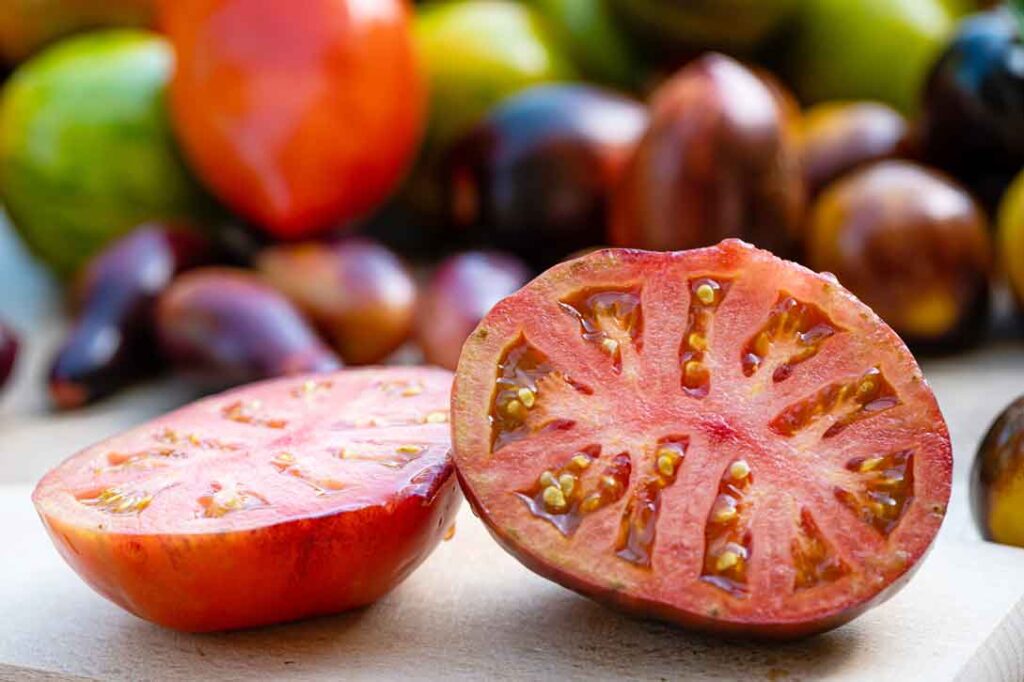
In designing our roadmap, this will be a crucial aspect for achieving the success we envision. The variety we select must take into account many variables, including the environment we have, the climate in which we will grow tomatoes, the availability of natural and economic resources, and, very importantly, a clear picture of our production and profitability goals.
Good. We’re able to examine the varieties we really need. We’re going to choose those that are most resistant to our climate variations, if that’s the case. Determinate varieties that produce fruit high off the ground will be more suitable if we start planting in the spring and summer seasons. The result will be a harvest suitable for processing, exporting, and selling in our usual markets.
Growing tomatoes in Spain: The most suitable varieties.
Muchamiel.
This indeterminate variety is perhaps the most widely cultivated in Spain. Native to the province of Alicante, it adapts very easily to the Mediterranean climate. Highly productive, with an intense, sweet flavor and deep red color, with an approximate growth cycle to harvest of between 80 and 90 days. The fruits are large, round, and slightly lobed. Its fleshy, juicy pulp allows us to make homemade sauces, stews, and fresh salads.
Muchamiel is well suited for planting in both domestic and urban gardens, as well as in large areas for commercial purposes, although it is advisable to monitor all development stages and processes to avoid diseases such as mildew and powdery mildew, which means its resistance level is intermediate. Due to its indeterminate nature, the Muchamiel tomato will produce flowers and fruit until the end of the growing season and in favorable climatic conditions, such as those found on the east and south coasts of the country.
As it is a vertical and robust growing plant, we will need the following controls:
- Implement appropriate tutoring to support the stems.
- Spread biodegradable paper mulch to prevent the fruit from coming into direct contact with the soil, maintain the necessary humidity and aeration levels, and inhibit the growth and proliferation of fungi and weeds.
- Prune regularly to maintain vital energy throughout the plant’s structure and allow for proper aeration of the planting.
- This variety is tolerant of high temperatures during the summer, but will require regular watering to prevent water stress and fruit cracking.
- If we want to extend production and profitability, it’s advisable to plant Muchamiel tomatoes in greenhouses so we can establish more controlled management of the entire cultivation and harvesting process.
Marmande.
This variety is highly valued not only in Spain, especially in areas such as the Valencian Community, Murcia, Andalusia, and Catalonia, but also throughout the rest of Europe. Originally from France, its cultivation has spread and adapted to the Mediterranean, Atlantic, and temperate climates, making it an excellent choice for urban gardens, greenhouses, and large commercial areas.
Marmande is also an indeterminate variety, growing vertically and continuously with a development cycle of 80 to 90 days from transplant. It will produce 4 to 6 tomatoes per shoot, as well as flowers and fruit throughout the season. Regular pruning and staking are also important for optimal results.
It requires continuous watering to prevent fruit cracking, and to avoid these risks, we need to use biodegradable paper mulch, as it retains the necessary soil moisture from the beginning of planting until harvest time.
Because it is a large, juicy fruit, it is very suitable for preparing stews, gourmet dishes, sauces, and fresh salads.
Planting tomatoes in Italy and France. Indeterminate varieties are most suitable.
In these Mediterranean regions and temperate climates, growing tomatoes is already a true tradition. These conditions are ideal for obtaining crops of excellent flavor, hardiness, and culinary quality. Below, we list the most commonly grown indeterminate varieties in these regions.
San Marzano: Campania, Italy. It requires well-drained soils and produces good yields in open fields. Its fruit is elongated, has a low water content, and has a thick pulp. Ideal for making sauces such as Napolitana, tomato sauce, preserves, and purees.
Costoluto Genovese: Italy, Genoa. It is a large, lobed fruit, with very good production in northern Italy and in greenhouses, and is especially valued in the preparation of salads, fresh sauces, and gourmet dishes.
Roma VF: This is an improved genetic variation of the Roma tomato, widely grown in southern Italy. Its elongated, seedless fruits are well-suited to tomato pastes, sauces, and preserves.
Piennolo del Vesuvio cherry: Naples, Italy. Small, sweet, and stored hanging in strings to dry and preserve them longer. Very resistant to dry climates and high temperatures, they are ideal for preparing salads, fresh dishes, and dehydrated dishes.
Marmande: As we’ve discussed previously, these fruits, native to the Marmande region of France, are very popular in local markets in Provence and Aquitaine. They’re especially good for preparing gourmet dishes, fresh sauces, and salads.
Coeur de Boeuf (Ox Heart): Large, heart-shaped, lobed fruits are highly prized in Parisian markets and suitable for serving sliced in gourmet dishes and fresh salads. They require strong, continuous training due to their large size.
Noire de Crimea (Crimean Black): These almost black fruits with a smoky flavor require soils rich in organic matter. They are also very popular in gourmet dishes and fresh salads.
Andean Cornue: elongated, curved, and almost pointed, which is why they are known as the Cornue des Andes. With fleshy flesh and few seeds, they are ideal for making mild sauces and stuffed tomatoes.
Biodegradable paper mulch for growing tomatoes.
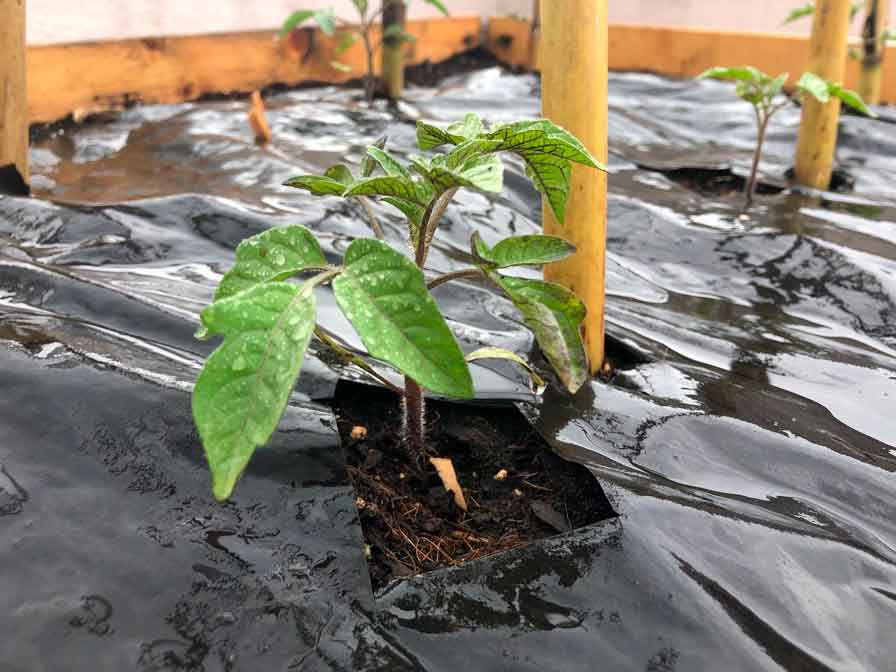
At this stage of our agricultural project, we must keep in mind that taking advance precautions guarantees the success of our project, especially if we reduce the initial investment and any additional costs we may have to pay throughout the rest of our crop’s journey.
By implementing biodegradable paper mulch, we’ll see very convenient and satisfactory results when harvesting our fruits, and at the same time, we’ll avoid unexpected costs that could erode our investment. Furthermore, we’ll achieve a sustainable crop of optimal quality.
Paper mulch is our true crop assistant. Spreading it on the soil once we’ve properly prepared the ground for growing tomatoes will balance moisture levels and inhibit the growth and proliferation of sedge and other weeds that can damage our plants’ root systems.
Furthermore, both the agronomic performance and the vegetative growth phase of our crops will develop with a high capacity for disease resistance and will produce robust, healthy fruit free of toxic chemical fertilizers that would be counterproductive when it comes to marketing our products.
Buy your biodegradable paper mulch here, for growing tomatoes.
-
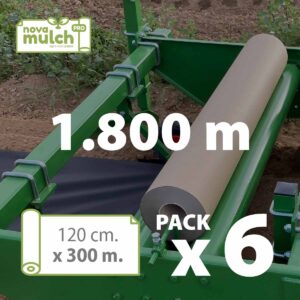 PACK of 6 rolls of Novamulch Professional paper 120 cm. x 300 m. (1.800 m)565,28 € IVA incluido
PACK of 6 rolls of Novamulch Professional paper 120 cm. x 300 m. (1.800 m)565,28 € IVA incluido -
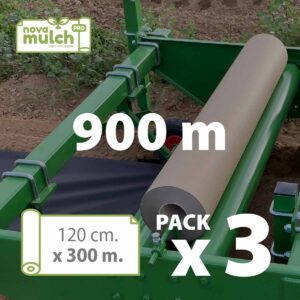 PACK of 3 rolls of Novamulch Professional paper 120 cm. x 300 m. (900 m)282,22 € IVA incluido
PACK of 3 rolls of Novamulch Professional paper 120 cm. x 300 m. (900 m)282,22 € IVA incluido -
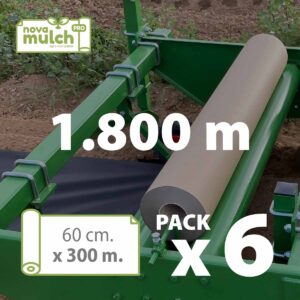 PACK of 6 rolls of Novamulch Professional paper 60 cm. x 300 m. (1.800 m)282,22 € IVA incluido
PACK of 6 rolls of Novamulch Professional paper 60 cm. x 300 m. (1.800 m)282,22 € IVA incluido -
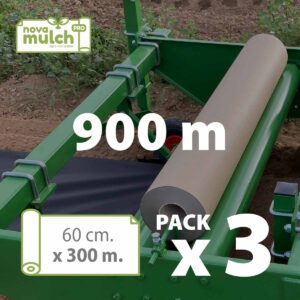 PACK of 3 rolls of Novamulch Professional paper 60 cm. x 300 m. (900 m)141,30 € IVA incluido
PACK of 3 rolls of Novamulch Professional paper 60 cm. x 300 m. (900 m)141,30 € IVA incluido -
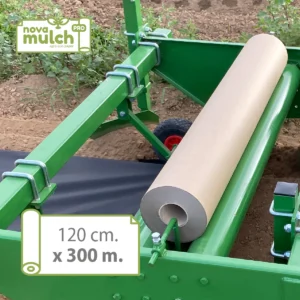 Novamulch Professional Paper 120 cm. x 300 m.94,21 € IVA incluido
Novamulch Professional Paper 120 cm. x 300 m.94,21 € IVA incluido -
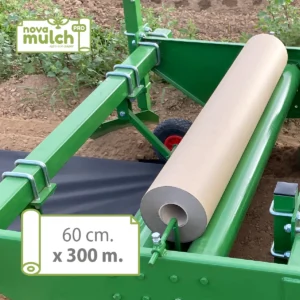 Novamulch Professional Paper 60 cm. x 300 m.47,10 € IVA incluido
Novamulch Professional Paper 60 cm. x 300 m.47,10 € IVA incluido -
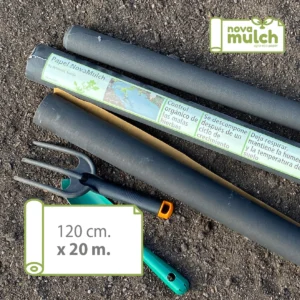 Novamulch paper 120 cm. x 20 m.41,63 € IVA incluido
Novamulch paper 120 cm. x 20 m.41,63 € IVA incluido -
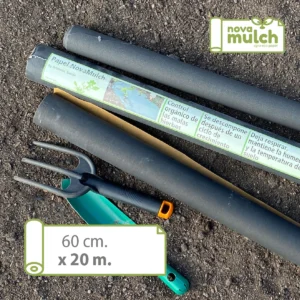 Novamulch paper 60 cm. x 20 m.21,89 € IVA incluido
Novamulch paper 60 cm. x 20 m.21,89 € IVA incluido -
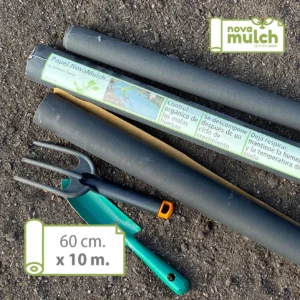 Novamulch paper 60 cm. x 10m.14,85 € IVA incluido
Novamulch paper 60 cm. x 10m.14,85 € IVA incluido -
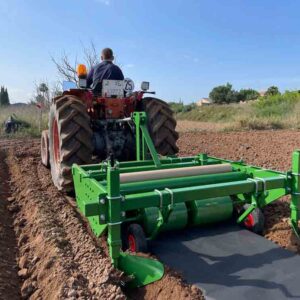 Novamulch agricultural mulching machine
Novamulch agricultural mulching machine
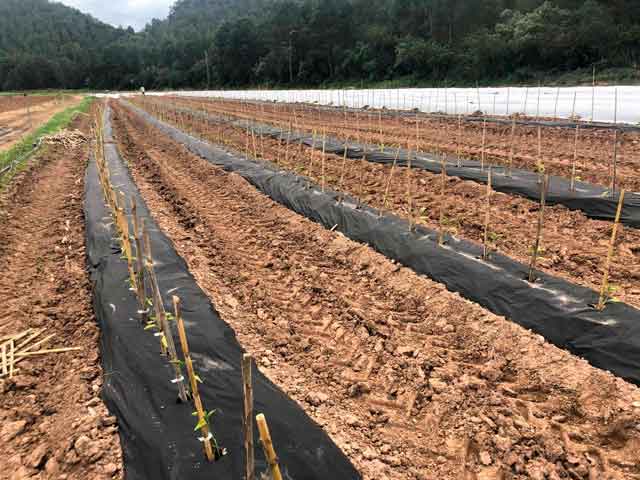
Suitable environments for growing tomatoes.
Let’s start with open field tomato crops.
If we live in regions with temperate to warm climates, it will be very beneficial to grow tomatoes outdoors where they can receive at least 6 or 8 hours of direct sunlight and develop in temperatures of 18° to 26° C.
The right soil should have good drainage capacity, a pH level between 6.0 and 6.8, and be rich in organic matter. It’s advisable to avoid growing tomatoes in areas that are susceptible to extreme temperatures, from severe frost to frequent drought, and where regular irrigation is limited.
By implementing biodegradable paper mulch, we’ll avoid unwanted unforeseen events by controlling proper moisture and nutrient levels, as well as the emergence and proliferation of weeds, fungi, and other common soil diseases.
Let’s also remember that, as our paper mulch biodegrades, we’ll rotate crops to recondition the soil, and by making the necessary amendments, we’ll be able to continue farming more safely by spreading our paper mulch again.
Growing Tomatoes in a Greenhouse.
In these cases, we’ll have much greater control over the habitat we need for healthy, robust plant growth. In a greenhouse, we can extend growth and harvest times, start planting during off-season, and also prevent and eliminate damage and problems caused by external factors.
The correct temperature to maintain during the day is between 21° and 27°C, and at night, we should aim for a balance of preferably 15°C. Humidity levels between 65% and 70% allow us to prevent common diseases and promote pollination, which can be assisted with the use of electric pollinators, for example.
Another important aspect is greenhouse ventilation. We’ll take steps to ensure smooth and constant air circulation within our habitat, thus preventing moisture buildup.
Growing Tomatoes in Pots and Containers
When we have limited spaces, such as balconies, terraces, and small patios, growing tomatoes can be a very satisfying and productive activity, as these species adapt easily to any area as long as they receive at least 6 to 8 hours of sunlight daily.
We’ll use pots or containers that are about 30 cm deep, with holes in the bottom for proper drainage. This will make it easier to move them around. We’ll prepare the soil with organic matter or compost, both well dissolved and free of plant debris, hard or plastic. We fertilize every 2 to 3 weeks with balanced levels of fertilizer. Remember that the soil must have good drainage capacity to avoid waterlogging.
Growing Hydroponic Tomatoes.
As we know, hydroponics is the cultivation of crops grown without soil; we use a nutrient base in the form of a solution. In these cases, we maintain a temperature of approximately 22° to 26°C and a pH between 5.5 and 6.5 to allow for proper nutrient absorption. It’s also very important to be able to control the aeration levels of the nutrient solution. We must periodically review—keep a log—our entire crop. The ideal environment for maintaining control over the entire hydroponic cultivation process is a greenhouse.
Suitable climate for growing tomatoes.
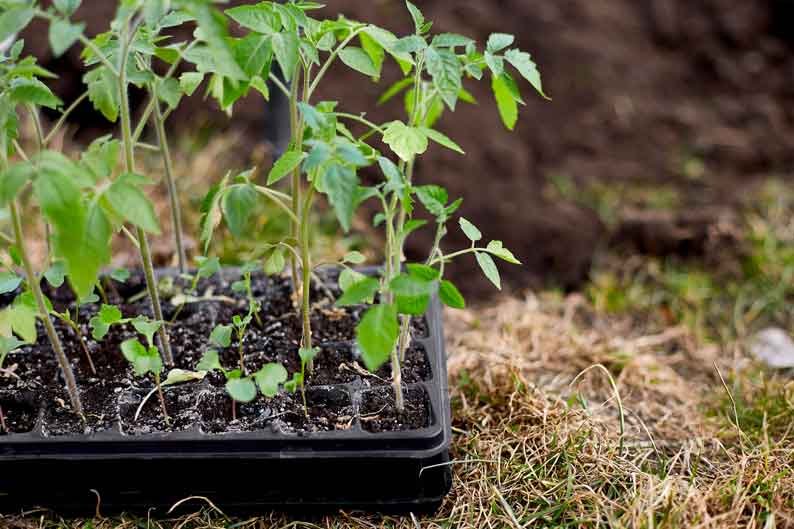
The Solanum lycopersicum family, of which our tomatoes are a part, are thermophilic plants, meaning they need warm temperatures to grow healthy and produce top-quality fruit. Therefore, they will thrive much better in tropical, subtropical, or Mediterranean climates.
Let’s study in detail the temperature levels that we will control at each step of our plants’ growth:
- Germination phase: optimal temperature of 20° to 30°C.
- Vegetative growth phase: 18° to 25°C.
- Flowering and setting phase: 20° to 24°C.
- Fruit ripening phase: 22° to 26°C.
We should avoid growing tomatoes at temperatures below 10°C and above 35°C, as our agricultural roadmap will not yield the results we desire. It’s also vital to keep in mind that the proper humidity level for healthy, robust fruit development is between 60% and 70%.
To achieve this, we implemented biodegradable paper mulch, which not only controls soil moisture levels and inhibits weed growth, but also reduces direct contact between leaves and fruit and the soil.
Note to keep in our crop records: Minimum sunlight (6 hours daily) and maximum sunlight (10 hours daily), so that we can be sure to successfully achieve adequate photosynthesis for vegetative development, levels of production of sugars and aromatic components of the fruit, and stability of leaf moisture.
Can we grow tomatoes in mountainous climates?
- While it’s true that these plants prefer warm, stable climates, they can be grown in mountainous areas as long as we select the most resistant varieties, maintain a carefully controlled agronomic management plan, and take measures to maintain a balanced microclimate.
- The advantage of planting tomatoes in these climates is that the soil temperature is improved, as less water evaporation occurs, and the initial development of the crop will occur more quickly.
- On the other hand, problems such as low temperatures at night and during several hours of the day, as well as late or early frosts, increased intensity of solar radiation, and uncontrolled evaporation from the crop can arise due to unforeseen weather changes.
It is advisable to take precautions in these cases. Let’s analyze:
- Select specific tomato varieties with short cycles and highly adaptable to limited seasons, such as Roma and San Marzano.
- We can implement microtunnels or thermal mesh to counteract low temperatures and thus protect seedlings during their vegetative growth.
- Spread biodegradable paper mulch to prevent potential damage to the root system from excess moisture or the invasion of weeds, pests, and diseases.
- We should apply organic foliar fertilizers to enhance the plant’s ability to absorb nutrients through its leaves, since growth slows during low temperatures.
Preparing the soil for growing tomatoes.
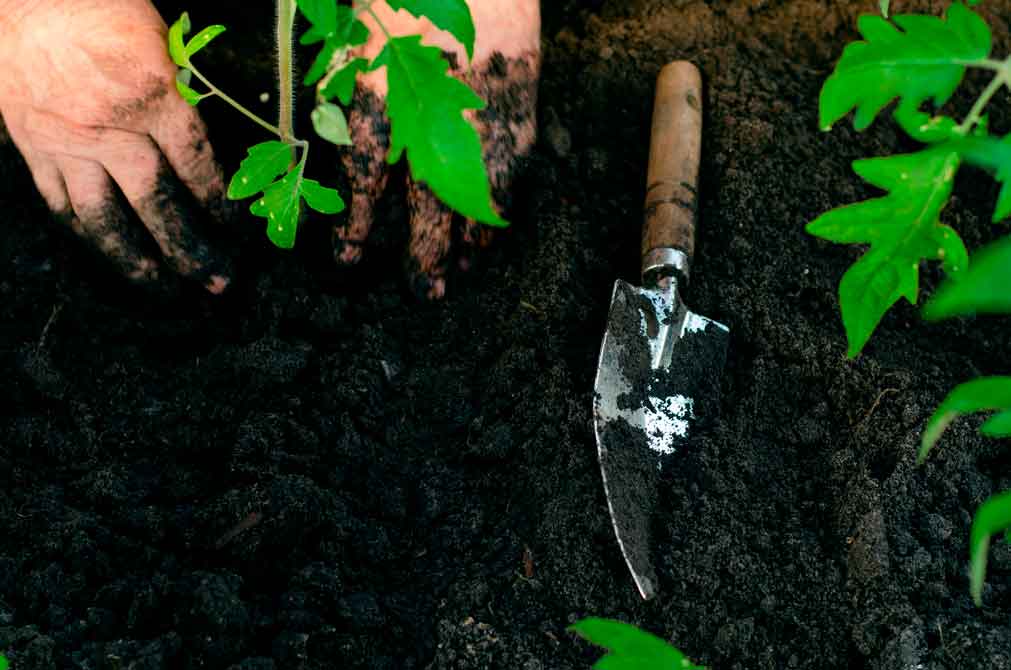
Now let’s make a plan to define how we should prepare the soil to plant tomatoes in different environments.
Preparing the soil in the open field.
It is the most common procedure generally followed in Mediterranean climates when designing home, community, or large-scale gardens.
First, we’ll analyze the soil we have and work it to break up any compaction to a depth of approximately 30 cm, removing hard, rocky materials, plastic or metal debris, remnants from previous crops, and emerging weeds.
Next, we’ll add the nutrients: mature manure or compost, always very loose and dry, and then we level the entire growing area to achieve uniform watering and prevent puddles from forming from the start of planting.
We will also make the necessary amendments to achieve a sandy loam composition that is light, loose, well-drained, well-aerated, and rich in nutrients. These soils should have an approximate composition of 60 to 70% sand, 20 to 30% silt, and 10 to 15% clay, resulting in a granular, easy-to-handle soil.
This type of soil allows for rapid root system development, and when combined with biodegradable paper mulch from the beginning of planting until harvest, we can prevent undesirable events such as the growth and proliferation of weeds and fungi, waterlogging, and soil degradation.
We must maintain a pH of 6.0 to 6.8 and a slightly acidic pH for proper nutrient absorption, as well as sufficient organic matter to enrich plant structure and microbial activity.
Preparing the soil in greenhouses.
In this type of environment, it’s important to take measures at the end of each planting season, as the soil can quickly become depleted, requiring preventive disinfection, solarization, and organic treatments to eradicate remaining and resistant pathogens.
Then we’ll add compost and worm castings to restore the proper microbial habitat, always on raised beds or raised beds so we can more easily manage our crops and ensure we control the entire water structure. Spreading biodegradable paper mulch before transplanting ensures robust, healthy plants and prevents them from coming into direct contact with the soil and moisture.
Preparing the soil in low-temperature climates and mountainous areas.
- Under these conditions, we will have lighter, more acidic soils that are not as rich in microbial activity due to the colder temperatures.
- We are then presented with different measures, such as making amendments in such a way that we achieve a pH of 6.0, and if it is lower, we will add agricultural lime, incorporate high-quality organic matter and manure, as we already know, well dissolved, decomposed and dry.
- We should avoid deep tilling, as this encourages the soil to cool. It is highly recommended to spread biodegradable paper mulch before planting to avoid subsequent problems and to retain sunlight during the day.
Preparing the soil in pots and containers.
These should be at least 30 cm deep, with sufficient holes in the base and a small layer of clay or gravel to allow for good drainage. Suitable components include approximately 40% fertile garden soil, 30% organic compost, 20% coconut fiber or perlite, and 10% worm castings. Always remember to keep a record of measurements and nutrient additions.
Fertilization and maintenance of tomato crops.
Following our roadmap for growing tomatoes, we now address two key aspects. We’ll analyze them to keep them in mind.
Pre-transplant fertilization: Add mature compost or worm castings and phosphorus-rich fertilizers to stimulate root system development, enhance nutrient absorption, and improve resistance and tolerance to the transplant process and potential soil-borne diseases. Apply low doses of nitrogen at this stage.
Vegetative growth phase: from day 15 after sowing, the stem, leaves and branches will begin to develop, and this is where we will apply higher but moderate doses of nitrogen, calcium and micronutrients (magnesium, zinc and boron).
Early flowering stage: Approximately 40 days after transplant, buds will form. We must add balanced levels of phosphorus, potassium, and boron to promote fruit set (the transformation of flowers into fruit). Once fruit set has begun, we will apply calcium and micronutrients, and higher doses of potassium.
Fruit development phase: We need high doses of potassium and reduce nitrogen levels to promote sugar accumulation and the growth of our tomatoes.
Ripening and harvesting stage: Even at this stage, we must add potassium and calcium to define and improve the color and flavor of the fruit, and we will water moderately.
Tomato harvest and storage times.
In this final stage, we’ll consider the variety we’ve chosen and the environment we’ve designed for planting tomatoes. Harvest time is approximately 60 to 90 days from the date of transplant.
We must ensure that our fruits are uniform in color, firm but elastic to the touch, and should yield slightly when pressed. When separated from the stem, they will detach effortlessly, and we will perceive a pleasant aroma. If planting tomatoes for commercial purposes, it is advisable to harvest them when our fruits begin to change color, before they acquire their final shades, to facilitate the transport process and extend their shelf life.
In warm regions and during the summer, we should harvest every 2 or 3 days, and in the fall, every 3 or 4 days. If we have grown in a greenhouse, it is advisable to harvest every 3 or 4 days as well. When we harvest at this frequency, we will avoid over-ripening our fruit, improve quality, and prevent disease.
To remove the fruit, we must turn it slowly until it comes loose, or cut it with clean, dry scissors. It is also necessary to remove any that are deformed, cracked, or damaged by pests, in order to avoid possible contamination.
How should we store tomatoes?
This is a delicate moment in our roadmap, as we will define the quality of our product here.
- The appropriate temperature for storing them is between 12° and 15°C. Lower temperatures will cause the fruit to lose its flavor and texture, and temperatures above this range accelerate ripening and, therefore, its shelf life.
- Likewise, a relative humidity of 85% to 90% will prevent our fruits from dehydrating and deforming.
- Storing fresh tomatoes in home refrigerators is counterproductive because their cell membranes weaken; it’s therefore advisable to place them in open boxes or trays and separate them by ripeness to achieve uniform storage.
- If we are going to consume our tomatoes immediately, we store them at room temperature in the shade and place them parallel to the maximum possible extent, to avoid crushing.
- Those destined for sale in local markets should be stored in ventilated boxes, cool and shaded, and transported during the first hours of the day. Tomatoes that are going to be processed into sauces, preserves, or for dehydration will be harvested at their peak ripeness, but it is important to begin processing within 24 to 48 hours after harvesting.
Common tomato pests and diseases.
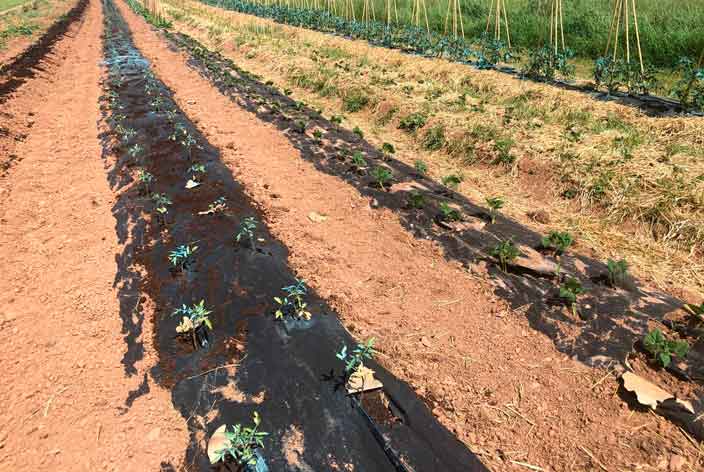
Let’s start by analyzing the common pests that invade our tomato crops.
Whitefly (Bemisia tabaci and Trialeurodes vaporariorum).
- Description: These are small white flies that nest on the underside of leaves, feeding on sap and gradually weakening the plant. They transmit the yellow leaf curl virus in tomatoes.
- Symptoms: The leaves turn yellow and curl up, and also develop sticky honeydew and sooty mold (black fungus).
- Control methods: place yellow chromatic traps, apply biological insecticides based on neem oil, and control biologically by introducing Encarsia Formosa: a small wasp of the Aphelinidae family, widely used in agriculture to specifically combat this whitefly, and in greenhouses to maintain control of tomato, cucumber, pepper and ornamental plant crops.
More information about this little wasp at this link:
https://es.wikipedia.org/wiki/Encarsia
Tuta absoluta (tomato moth).
- Description: This is one of the most invasive and damaging pests in tomato crops. The larvae bore into the entire plant structure and weaken its defenses against other infections.
- Symptoms: The leaves show perforations, irreversible damage occurs inside the fruits, and larvae and excrement appear on the leaves.
- Control methods: Place pheromone traps, install insect netting, and apply Bacillus thuringiensis-based products as a preventative measure by spraying all foliage.
Here we present some interesting information:
https://es.wikipedia.org/wiki/Bacillus_thuringiensis
Aphids (Myzus persicae and others).
- Description: They are insect vectors of viruses, that is, living organisms that rapidly spread viral diseases from contaminated plants to healthy plants. They are very common in warm, humid climates. Aphids are highly contaminating and transmit viruses that can completely damage an entire crop.
- Symptoms: shoots that grow with deformities in their structure, curled, sticky leaves, and the presence of ants associated with these insects.
- Control methods: Spread biodegradable paper mulch before transplanting to control humidity in the area, intervene with ladybugs, and apply potassium soap to the soil.
This information may be of interest to us:
https://es.wikipedia.org/wiki/Aphidoidea
Now let’s review the common diseases in tomato cultivation.
Mildiu (Phytophthora infestans).
- Description: It is a fungus that thrives in humid climates and moderate temperatures, and if we don’t detect it in time we run the risk of losing our entire crop.
- Symptoms: The plant structure begins to show grayish spots, and in areas with higher humidity levels, we observe premature leaf drop and general decomposition of our tomatoes.
- Control methods: Design the growing area to allow for continuous ventilation, implement preventative treatments with copper or approved plant extracts, and spread biodegradable paper mulch before transplanting to prevent all the symptoms that facilitate the appearance of these pests and diseases.
Oídio (Leveillula taurica, Oidium lycopersicum).
- Description: It appears as a white powder on the leaves, especially in greenhouses and poorly ventilated spaces.
- Symptoms: white powder, discoloration and premature fall of foliage, very slow and almost stopped growth.
- Control methods: Control excess moisture and continued water evaporation by pre-spreading biodegradable paper mulch and adding wettable sulfur to reduce damage.
Botritis o moho gris (Botrytis cinerea).
- Description: This disease appears in conditions of high humidity and completely affects the entire structure of the plant.
- Symptoms: Gray mold and soft rot, rapidly expanding water-soaked lesions, and
- Symptoms: Gray mold and soft rot, rapidly expanding water-soaked lesions, and
- Control methods: Remove infected parts without leaving any residue, irrigate only toward the soil and not toward the foliage, and use biodegradable paper mulch beforehand to prevent fruit from coming into contact with the soil.
Tomato mosaic virus (ToMV).
- Description: This virus is an irreversible disease that is transmitted by any type of contact and insect vectors.
- Symptoms: The foliage develops light and dark green mosaic-like spots, and the fruit becomes deformed and stained, rendering it unfit for consumption.
- Control methods: Carefully wash and disinfect tools, remove infected plants without leaving residue, and select certified seeds with current dates whenever possible.
Final Reflections.
Whenever we envision growing tomatoes as part of our agricultural roadmap, we’ll make a detailed plan in advance to cover all the unexpected as much as possible. We’ll study and take notes on the environmental and climate conditions in which we’ll begin our crop, considering our ability to handle (and enjoy) the steps of proper maintenance, fertilization, pruning, harvesting, and storage of our crops.
Depending on our stated goals, whether commercial, domestic, or simply for the pleasure of having that wonderful and enriching experience of watching our crops grow and nurture them step by step, we will take precautions to ensure we successfully achieve our initial idea with optimal results.
Growing tomatoes represents an activity that will help us grow day by day, in knowledge and the acquisition of new skills to safely handle all the events that may arise during this beautiful growth process.
Part of this learning process is having our protective assistant, biodegradable paper mulch, which benefits us from the beginning to the end of our plan, and we avoid making additional investments because this material covers all the agricultural and sustainable needs, from transplanting seedlings or sowing seeds, to harvesting robust, healthy tomatoes that are highly desirable for us and for the market to which we will destine them.
So, let’s get to work and good luck!

